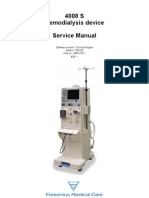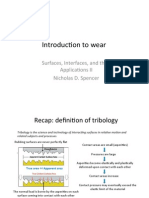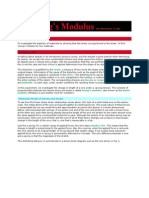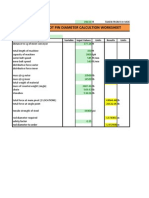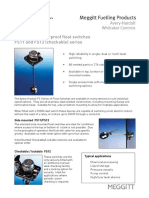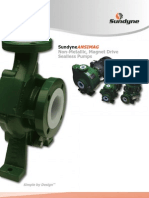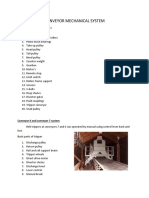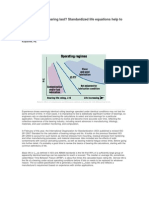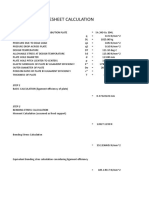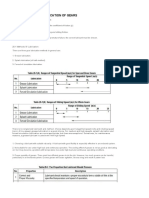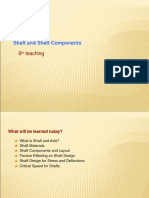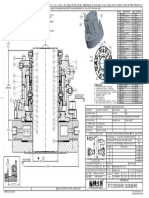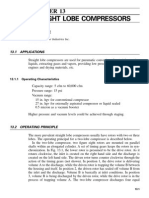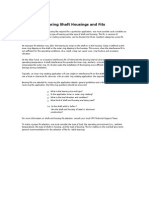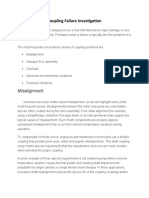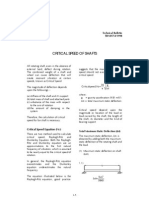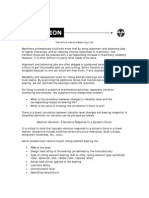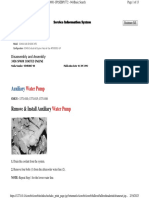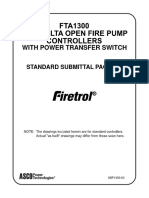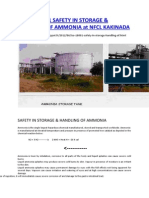The Effect of Unbalance On Bearing Life
The Effect of Unbalance On Bearing Life
Uploaded by
jaypallaCopyright:
Available Formats
The Effect of Unbalance On Bearing Life
The Effect of Unbalance On Bearing Life
Uploaded by
jaypallaOriginal Description:
Original Title
Copyright
Available Formats
Share this document
Did you find this document useful?
Is this content inappropriate?
Copyright:
Available Formats
The Effect of Unbalance On Bearing Life
The Effect of Unbalance On Bearing Life
Uploaded by
jaypallaCopyright:
Available Formats
IOSR Journal of Mechanical and Civil Engineering (IOSRJMCE)
ISSN : 2278-1684 Volume 1, Issue 2 (July-Aug 2012), PP 47-54
www.iosrjournals.org
The Effect of Unbalance on Bearing Life
SANJAY TANEJA
Associate Professor, Department of mechanical engineering.
Manav Rachna College of Engineering,
Faridabad, India
Abstract: The life of bearing is closely related to its loads which are affected by the eccentric unbalances of
rotational components in the structure system of the bearing. However, since the bearing structure in some of
the machinery is complicated, the exact load calculations and the life prediction for this kind of bearing are
difficult. The load and life calculation for the bearing are developed with considering the magnitude of eccentric
unbalances. The influences of unbalances on the loads and life of the bearing are studied. The calculation and
analysis results show that the radial loads on rolling element of the bearing fluctuate significantly under the
actions of the unbalances of different parts of machines and the bearing life reduces regularly with the eccentric
unbalances changing. In this article, I have focused not on machines that are supposed to vibrate as part of
normal operation, but on those that should not vibrate: electric motors, rotary pumps and compressors, and
fans and blowers. In these devices, smoother operation is generally better, and a machine running with zero
vibration is the ideal.
Keywords: permissible residual unbalance; eccentricity ,maru, urr, pump bearing
Nomenclature
E =Eccentricity
G = Balancing quality grade
U per = The maximum residual unbalance
F lbs. = Force due to unbalance
MARU =Minimum achievable residual unbalance test
URR =Unbalance reduction ratio
L10h= Basic rating life of the ball bearing (h)
P = Effective load (actual force applied to the bearing)
C = Published catalog load rating
mCf=the eccentric unbalance of the cooling fan (g cm) in a pump
mCb=the eccentric unbalance of the driving wheel (g cm) in a pump
I.
Introduction
Research showed that in the automobile wheel and its shaft had to be in a state of balance, i.e. the mass
had to be evenly distributed about the rotating centerline so that the resultant vibration was at a minimum. This
had to be achieved during the manufacturing process so that maximum service life could be achieved from the
system. Imbalance could be caused by manufacturing defects (machining errors, casting flaws) or maintenance
issues (deformed or dirty fan blades, missing balance weights). As machine speed increases, the effects of
imbalance become greater. Imbalance can severely reduce bearing life as well as cause undue machine
vibration.
A level of unbalance that is acceptable at a low speed is completely unacceptable at a higher speed.
This is because the unbalance condition produces centrifugal force, which increases as the speed increases. In
fact the forces caused by unbalance increases by the square of the speed. If the speed is doubled, the force
quadruples; if the speed is tripled the force increases by a factor of nine.
It is the force that causes vibration of the bearings and surrounding structure. Prolonged exposure to the
vibration results in damage and increased downtime of the machine. Vibration can also be transmitted to
adjacent machinery, affecting their accuracy or performance. Load determination and life prediction calculation
of the bearing are the premises of a good bearing design and a reasonable working condition matching, and yet
it is one of difficulties in the practical application. In some cases, vibration is inherent in machine design. For
instance, some vibration is almost unavoidable in the operation of reciprocating pumps and compressors,
internal combustion engines, and gear drives. In a well-engineered, well-maintained machine, such vibration
should be no cause for concern. In simplest terms, vibration in motorized equipment is merely the back and
www.iosrjournals.org
47 | Page
The Effect of Unbalance on Bearing Life
forth movement or oscillation of machines and components, such as drive motors, driven devices (pumps,
compressors and so on) and the bearings, shafts, gears, belts and other elements that make up mechanical
systems.
From previous studies, it is not difficult to know that the internal load distribution of rolling element
bearing is closely related to the external loads which are usually assumed to be invariable.
Machinery professionals intuitively know that by doing alignment and balancing jobs to tighter
tolerances, and by reducing internal clearances in machinery, that vibration levels will be reduced with a
corresponding increase in machinery reliability. However, it is often difficult to justify what needs to be done.
Reliability and replacement costs for rolling element bearings are major concerns in most plants.
II.
Literature Review
When man invented the wheel, he very quickly learned that if it wasnt
completely round and if it didnt rotate evenly about its central axis, then he had a problem! Modern man still
suffers from the same problem only now the problem is amplified.
As machine first patent for balancing technology was filed by Henry Martinson of Canada in 1870,
four years after the development of the dynamo by Siemens. Near the turn of the century, Akimoff (USA) and
Stodola (Switzerland) attempted to develop Martinson's technology and apply it for industrial use. However, it
was in 1907 when a modified version of the technology was patented by Dr. Franz Lawaczek, and offered to
Carl Schenck, Darmstadt, Germany, for development. Schenck built the first industrial two-plane balancer, and
subsequently bought exclusive world rights to the dynamic balancing machine in 1915.
Technology advancements gave way to improved sensitivity, frequency selectivity and plane separation
capability. The development of electronics and mechanical/electrical transducers, greatly reduced balancing
time and paved the way for modern balancing technology.
Today balancing equipment is used with confidence for a wide range of applications - from the smallest
rotors for dental drill instruments to the largest steam turbines in the world. Precision balancing machines assure
accurate, dependable rotor operation.
Now a days balancing industry provides a complete range of balancing, diagnostic and special
equipment for the automobile industry, power generation industry, medical, aviation industries and an
engineering staff that offers a broad range of experience for nearly any balancing application which involves
different sizes of bearings starting from dental drill bearing sizes (very small) to aviation/power generation rotor
bearing (extremely big) sizes.
III.
Basic Bearing Life Equation
Examining the basic bearing life equation we find that speed, load and the type of bearing are factors:
L10h = (16667 / rpm) x (C / P)r
Where:
L10h = 90th percentile of life in hours (the point at which only 10 percent of bearings in identical
applications fail);
Note: average life = 5 x L10h
Rpm = Rotational speed of the bearing
C = Published catalog load rating
P = Effective load (actual force applied to the bearing)
r = 3 for ball bearings
r = 3 1/3 for other types of rolling element bearings
3.1
FACTORS AFFECTING BEARING LIFE
For those involved in predictive maintenance activities, especially vibration monitoring and analysis,
two questions have always been present.
What is the correlation between changes in vibration level and the corresponding impact on bearing life?
What is the value in knowing this correlation if there is one?
Few predominant factors affecting impact rolling element bearing life are:
RPM of the shaft
Design load rating of the bearing (as defined by the manufacturer)
Type of rolling element bearing (ball or other rolling element type-cylindrical roller, spherical roller, needle
roller, tapered roller)
Actual load (force) applied to the bearing
Lubricant ability
Contamination level
Operating temperature.
First, lets investigate the impact of rotational speed on bearing life. Reviewing the basic bearing life equation:
www.iosrjournals.org
48 | Page
The Effect of Unbalance on Bearing Life
L10h = (16667 / rpm) x (C / P)r
The impact of increasing speed is obvious. Doubling the rotational speed (while maintaining a constant load) =
L10h / 2 = 1/2 the original life.
Equation results:
2 x rpm = 1/2 life
3 x rpm = 1/3 life
1.25 x rpm = 0.8 life
Next, there is a need to investigate the impact of load on bearing life. Reviewing the basic bearing life equation
again:
L10h = (16667 / rpm) x (C / P)r.
The impact of increasing load (force) is pronounced.
Doubling load (while maintaining a constant speed) = L10h / 8 or 1/8 life (1/2)3 for ball bearings.
The L10 bearing life is a published number and it is calculated as:
L10 = (16,667/RPM)*(rated load/actual load)3
The L10 life of a bearing is the life expectancy for 90% of the population, where a full load life is estimated at
1,000,000 revolutions. Guidelines for loading are as follows:
Light loading at <6%
Normal loading at 6% to 12%
Heaving loading at >12%.
Typically, this works out to be a life expectancy from a few months to several years at continuous 365-day/24hour usage.
TABLE-1
Other rolling element bearing types include cylindrical, spherical, tapered and needle bearings.
IMPACT OF INCREASED LOAD ON BEARING LIFE
Percentage Life Decrease
% Load Increase
Ball Bearings Other Rolling Element
Bearing Types1
5
14
15
10
25
27
15
34
37
20
42
46
25
49
52
50
75
70
81
74
85
100
87
90
vibration in motorized equipment is merely the back and forth movement or oscillation of machines
and components, such as drive motors, driven devices (pumps, compressors and so on) and the bearings, shafts,
gears, belts and other elements that make up mechanical systems.
TABLE-2
FORCES AND SOURCES OF VIBRATION
Force Source
Type of Force
Reducible
Unbalance
Dynamic
Yes
Shaft Misalignment Dynamic & Static Yes
Belt / Drive Tension Static
Yes,
if
Excessive
Tension is Present
Looseness
Dynamic
Yes,
if
Excessive
Looseness is Present
Rotor Weight
Static
No, Not Normally
Gear Reaction
Dynamic & Static No
Process Forces
Dynamic & Static No, Not Normally
Of these seven different forces, only the first four can normally be addressed by the maintenance
department. The other three are machine design related and are not normally reducible.
www.iosrjournals.org
49 | Page
The Effect of Unbalance on Bearing Life
TABLE-3
IMPACT OF VIBRATION REDUCTION ON BEARING LIFE
(Assuming dynamic load is the major force component)
Percentage Increase in Bearing Life
% Reduction in
Ball Bearing Types Other Rolling Element
Vibration
Bearing
5
17
19
10
37
42
15
63
72
20
95
110
25
137
161
30
192
228
40
363
449
50
700
908
IV.
Effect Of Unbalanced Forces
Unbalance is one of the primary sources of machine vibration. The force produced due to unbalance can be
calculated using either of the following formulae:
F lbs. = 0.062 x (rpm / 1000)2 x U gm. In. Where:
1 gm. in. = 1 gm. of mass @ 1 in. of radius from centerline of rotation
Because unbalance is a rotating load, the bearings inner race is zone loaded. This is a different type of loading
compared to most of the other force sources.
Fig 1
Because unbalance is a rotating load or force, the following conversion must be made to use this force in the
bearing life equation:
P = F lbs. x fm
Where:
F lbs. = Force due to unbalance
fm = Factor of 1.0 to 1.5 according to the ratio of static force compared to the unbalance force on the bearing
(When this ratio is 1.0 then the factor is 1.333)
4.1
CALCULATION OF PERMISSIBLE RESIDUAL UNBALANCE
U per the maximum residual unbalance permitted for a
rotor or in a correction plane[4].
U per = e per x m
where m = rotor mass
Calculation of permissible unbalance for a pulley of radius 152 mm running at 800 r.p.m, having 8.1 kg weight.
Speed, n = 800 rpm
Weight of pulley, P = 8.1 kg
Radius of pulley, R = 152 mm
(O.D. is 314mm)
Balancing grade, G = 4 (means vibration speed=4mm/s for pulley)[3}
Max. residual unbalance e=10XG/nx1000=10x4/800x1000=50m
e=p x R/P
p=e x P/R =50X8.1/152=2.66KG
Therefore the Permissible Residual Eccentricity is 50m & the Permissible
Residual Unbalance is 2.66g for this Pulley.
www.iosrjournals.org
50 | Page
The Effect of Unbalance on Bearing Life
Another way to calculate permissible unbalance in balancing machines
U per (g-mm) = 9549 x G x W/N (W in kg)
G = Balance quality grade from Table 4
W = Rotor weight
N = Maximum service RPM
MARU (Minimum achievable residual unbalance test) and URR (unbalance reduction ratio) test are performed
to test reliability of balancing machines.[1]
4.2
INFLUENCES OF THE UNBALANCE CHANGES ON THE BEARING LOADS
An imbalance in the motor, for instance, would most likely cause a radial vibration as the heavy spot
in the motor rotates, creating a centrifugal force that tugs the motor outward as the shaft rotates through 360
degrees. Another key factor in vibration is amplitude, or how much force or severity the vibration has. The
farther out of balance our motor is, the greater its amplitude of vibration. Other factors, such as speed of
rotation, can also affect vibration amplitude. As rotation rate goes up, the imbalance force increases
significantly.
Frequency refers to the oscillation rate of vibration, or how rapidly the machine tends to move back and
forth under the force of the condition or conditions causing the vibration.
The calculation results of the radial loads on a pump were obtained under the given eccentric
unbalance= mCb = 15 g cm of the pump driving belt wheel, and m Cf = 30 g cm of the cooling fan. [11],[12].
To analyze the changes of the radial loads when the eccentric unbalances change gradually, two cases
are discussed. One case is that three sets of m Cb, i.e. 0 g cm, 15 g cm and 30 g cm are selected and the eccentric
unbalance of the wheel keeps invariant with the value of zero. The other is that the eccentric unbalance of the
fan is selected as 0 g cm, 30 g cm and 60 g cm respectively, and the eccentric unbalance of the wheel is reset to
zero. The radial load variations on the two rolling element rows of the bearing in one rotational period of the
cooling fan, with the eccentric unbalance of the fan changing, are shown in Fig. 3. In a similar manner, the
radial load variations with the eccentric unbalance of the wheel changing in the same period are shown in
Fig. 4.[12]
The calculation results show that for the given water pump bearing, the fluctuation range of the radial
load on row I(impeller side) is enlarged with the eccentric unbalance increasing of the cooling fan, while the
radial load on row II (fan side)increases proportionally.
Fig. 2. Structure view of the water pump bearing.
A-1
A-2
www.iosrjournals.org
51 | Page
The Effect of Unbalance on Bearing Life
B-1
B-2
Fig. 3. Radial loads on two rolling element rows in one rotational period of the cooling fan: (A) Fr1 under
different fan unbalances; (B) Fr2 under different fan unbalances.[12]
A-2
A-1
B-1
www.iosrjournals.org
52 | Page
The Effect of Unbalance on Bearing Life
B-2
Fig. 4. Radial loads on two rolling element rows in one rotational period of the cooling fan: (A) Fr1
under different wheel unbalances. (B) Fr2 under different wheel unbalances.[12]
The mean dynamic equivalent radial loads are heavily influenced by the fan unbalance. On the
contrary, the influences of the wheel unbalance on the mean dynamic equivalent radial loads are little. This may
be caused by the fact that the cooling fan is located far away from the pump bearing and the driving wheel is
near the pump bearing.
TABLE 4
QUALITY GRADES AS PER ISO-1940
Balance quality grade
G
Rotor types
G 100
Crankshaft
drives
of
large
Diesel
Complete engines for trucks and locomotives
G 40
Crankshaft drives for engines of trucks and locomotives
G 16
Parts
of
crushing
Parts of agricultural machinery
G 6.3
Fly-wheels
Fans
Aircraft
Electrical
Process
Pump impellers
gas
turbine
engines
machinery
plant
rotors
armatures
machinery
electric
drives
compressors
armatures
G 2.5
Machine-tool
Turbo
Small
Turbine-driven pumps
G1
Grinding
Textile
Automotive turbochargers
machine
drives
bobbins
Gyroscopes
Disk-drives
Spindles for high-precision applications
Different quality grades are provided in I.S.O 1940 for a specific component depending upon
Criticalness and accuracy required for his application.
Based on this suitable value of balancing tolerance can be calculated as per his application in different field as
described above.[1],[2].
G 0.4
V.
CONCLUSION
Vibration is a characteristic of virtually all industrial machines. When vibration increases beyond
normal levels, it may indicate only normal wear or it may signal the need for further assessment of the
underlying causes, or for immediate maintenance action.
Understanding why vibration occurs and how it manifests itself is a key first step toward preventing
vibration from causing trouble in the production environment. Reducing the forces caused by unbalance,
looseness and misalignment will result in lower vibration levels for machines. Reducing excessive belt tension
will also reduce machine forces but will not produce an appreciable reduction in vibration level. The vibrations
themselves have only a minor impact on bearing life but the forces which cause these vibrations have a major
www.iosrjournals.org
53 | Page
The Effect of Unbalance on Bearing Life
impact on the actual bearings longevity. In addition to improving reliability and reducing the cost of
maintenance of machines, several more benefits are obtained by reducing vibration levels:
Reduced Noise Levels
Reduced Operating Costs (Utilities)
Improved Operating Safety
Improved Maintenance Technician Morale
Increased Life for Related Machine Components (seals, housings, shafts, impellers, windings, etc.)
Reducing vibration levels on machines by correcting common machine problems or applying tighter tolerances
does indeed dramatically improve bearing life and reduce maintenance and operating costs.[9]
RESULT 1- Bearing life is inversely proportional to speed changes.
(1 / speed change ratio)
RESULT2- Increased load results in an inversely exponential reduction in life.
RESULT3- Unbalance is up to 50 percent more destructive to bearing life than other vibration sources
producing equal vibration levels.
RESULT4- In a specific example of water pump the basic rating life of the bearing changes slowly when the
fan unbalance is constant and the wheel unbalance increases from zero to 150 g cm.
When the wheel unbalance is constant and the fan unbalance varies in the range of 010 g cm, the basic
rating life of the bearing decreases less than 900 h. The reduction is also very little. However, the reduction of
the basic rating life is nearly 7000 h when the fan unbalance increases from 10 g cm to 30 g cm. The life of the
bearing reduces much faster and the life variation reaches to 16 000 h when the fan unbalance varies from
30 g cm up to 60 g cm, [12] with keeping the wheel unbalance constant.
The above results show that small eccentric unbalances have small effect on the life of the water pump
bearing, but if the eccentric unbalances, especially the fan unbalance, go beyond some threshold value, the life
of the pump bearing would reduce sharply.[8]
In this paper the influences of the unbalance variations on the bearing life were studied. It was found
that the unbalances will cause reduction of the bearing life [7]and this effect would be remarkable if the
unbalances increased to a certain level.
The main component of the vibration is unbalance of the rotor and the rotor weight is nominal.
Currently if the rotor is balanced to a tolerance of ISO G6.3. per plane then by adjusting this balancing tolerance
to ISO G3.2 per plane, the bearing life should be extended by 700 percent. Since the vibration should be cut in
half as a result of the improved balance tolerance,
5.1 Future scope
Further area of this study can be extended for analyzing the effect of unbalances on bearings of
different industrial machines of different nature such as production machines of different application, mixer,
grinder, axles in automobile etc. It will also be immensely helpful in the areas of increasing life of critical
machines such as power generation machines (turbine and other moving parts),dental drills, aviation rotors,
turbo chargers.
Sometimes these analysis are providing important tips for changing the design Of specific
machine.(such as changing the bearing position inside the housing)
References
[1]
[2]
[3]
[4]
[5]
[6]
[7]
[8]
[9]
[10]
[11]
[12]
ANSI S2. 19-1975 "Balance Quality Requirements of Rotating Rigid Bodies. "American National Standards Institute.
ISO 1940-1:1986, Balance Quality Requirements of Rigid Rotors." British Standards Institution. BS 6861-1:1987,
"Balance Quality Requirements of Rigid Rotors." International Organization for Standardization.. ISO 1940 STANDARD For
Balancing Masses1. ISO 1940/1,
"Balance Quality Requirements of Rigid Rotors." German Standards Institution. The Practical Application of ISO 1940/1, VDI 2060,
DYNAMIC BALANCING HANDBOOK, "October 1990, IRD Mechanalysis Inc.
ISO 1925, Balancing Vocabulary .International Organization for Standardization.
Dynamic capacity of rolling bearings G. Lundberg, A. Palmgren
Acta Polytech. Mech. Eng. Ser., 1 (3) (1947), p. 7
Guide bearing probability load theory of large vertical pump , Mech. Mach. Theory, 42 (2007), pp. 119912097]
Modern Pump Technology Handbook
(1st edition) China Astronautic Publishing House, Beijing (1995) B. Qiu, H. Lin, S. Yuan, X.F. Guan
Reliability Magazine Reprinted courtesy of Reliability Magazine.
Article written by L. Douglas Berry in 12/95 issue
Rolling Bearing Analysis (1st edition)John Wiley and sons, T.A. Harris,New York (1966)
The influence of bearings on pump performance, World Pumps (September) (2004) 4649. P. Burge
The research on the life of auto water pump bearing considering the rigidity of bearing spindle
Koyo (136) (1989), pp. 5163 Sakuragi
www.iosrjournals.org
54 | Page
You might also like
- Technote #34 Rotalign: Rotalign Ment of Cardan Shafts Using Cardan Bracket Ali 2.893setDocument5 pagesTechnote #34 Rotalign: Rotalign Ment of Cardan Shafts Using Cardan Bracket Ali 2.893setCarlos M100% (1)
- Materials Handling and HoistingDocument6 pagesMaterials Handling and HoistingNARGISNo ratings yet
- 4008 S ImagineDocument366 pages4008 S ImagineCesar Alfonso Saldivar Montoya76% (45)
- Introduc) On To Wear: Surfaces, Interfaces, and Their Applica) Ons II Nicholas D. SpencerDocument26 pagesIntroduc) On To Wear: Surfaces, Interfaces, and Their Applica) Ons II Nicholas D. SpencerKunal PandeyNo ratings yet
- Reverse Dial Alignment ProcedureDocument7 pagesReverse Dial Alignment Procedureazroy06No ratings yet
- Young's ModulusDocument7 pagesYoung's ModulusNgatno100% (1)
- MC Design 2Document71 pagesMC Design 2Upayan Ghatak100% (1)
- Fluida (English)Document56 pagesFluida (English)aliNo ratings yet
- F-03 Self-cleaningFiltersManual & AutomaticAIRPELDocument4 pagesF-03 Self-cleaningFiltersManual & AutomaticAIRPELdevang asher100% (1)
- Main Pivot Pin Dia CalculationDocument2 pagesMain Pivot Pin Dia Calculationjdutia83100% (1)
- Weatherproof Float SwitchDocument4 pagesWeatherproof Float Switchprihartono_diasNo ratings yet
- Grease Lubrication QuantityDocument10 pagesGrease Lubrication QuantitySUNIL TVNo ratings yet
- Fans in Air Handling Units - WTP 38 2Document23 pagesFans in Air Handling Units - WTP 38 2jameeloNo ratings yet
- Pump SealsDocument8 pagesPump SealsSaurabh Kumar100% (1)
- 2 Caterpillar Drive ChainDocument1 page2 Caterpillar Drive ChainFernando Mendoza0% (1)
- Document'S Code Attachment 10.3 Revision 0: ClientDocument4 pagesDocument'S Code Attachment 10.3 Revision 0: ClientrfriosEP100% (1)
- Volume CalcDocument6 pagesVolume CalcNikhil Ashok Badgu100% (1)
- Pivot PinDocument1 pagePivot Pinsourajpatel001100% (1)
- Welcome To The Bill Pentz Cyclone Design Spreadsheet.: 0 No 1 YesDocument10 pagesWelcome To The Bill Pentz Cyclone Design Spreadsheet.: 0 No 1 YesMarcelo Morais100% (1)
- Engineering SectionDocument176 pagesEngineering Sectionlhgrahl100% (1)
- Rotating Disc ValvesDocument4 pagesRotating Disc ValvesSergey100% (1)
- AnsimagDocument8 pagesAnsimagmani_208eeNo ratings yet
- Conveyor Mechanical SystemDocument7 pagesConveyor Mechanical SystemEmmanuel Kimmayong BenitezNo ratings yet
- How Long Will A Bearing Last? Standardized Life Equations Help To AnswerDocument3 pagesHow Long Will A Bearing Last? Standardized Life Equations Help To AnswervijaykhandgeNo ratings yet
- WS Palo1 Nov2014Document26 pagesWS Palo1 Nov2014phantanthanhNo ratings yet
- Preconstruction MeetingDocument32 pagesPreconstruction MeetingMar OlacsNo ratings yet
- Pressure and Flow MeasurementDocument16 pagesPressure and Flow MeasurementMohamed KhateebNo ratings yet
- SprayAdvantage 2018 CatalogDocument226 pagesSprayAdvantage 2018 CatalogJoe100% (1)
- Conceptual Diagram of A Plate and Frame Heat Exchanger02Document9 pagesConceptual Diagram of A Plate and Frame Heat Exchanger02sai thesisNo ratings yet
- Tubesheet Calculation: Step 1Document2 pagesTubesheet Calculation: Step 1Bintang LazuardiNo ratings yet
- Belt Scale Handbookaa 180626111648 PDFDocument29 pagesBelt Scale Handbookaa 180626111648 PDFrbounaNo ratings yet
- 722222-CD-000-PIP-MTO-001 - Piping, Fitting, Flange, Gasket, Bolt - Nut - RA (Aboveground)Document16 pages722222-CD-000-PIP-MTO-001 - Piping, Fitting, Flange, Gasket, Bolt - Nut - RA (Aboveground)rianafrian2611No ratings yet
- Air Receiver Sizing PDFDocument3 pagesAir Receiver Sizing PDFTifano KhristiyantoNo ratings yet
- Overhead Conveyor Products PDFDocument16 pagesOverhead Conveyor Products PDFPierre Hopkins100% (1)
- Beginner Guide Machine VibrationDocument74 pagesBeginner Guide Machine VibrationvinothenergyNo ratings yet
- Psychrometric DiagramDocument6 pagesPsychrometric DiagramDavid LambertNo ratings yet
- Hydrodynamic Journal Bearing CalculatorDocument2 pagesHydrodynamic Journal Bearing CalculatorsvhnagendraNo ratings yet
- Lift Lug AnalysisDocument2 pagesLift Lug AnalysisTito FebriantoNo ratings yet
- Forged Steel Pipe Fittings (OK)Document18 pagesForged Steel Pipe Fittings (OK)truongNo ratings yet
- Helical Gear Lubrication RequirementDocument7 pagesHelical Gear Lubrication RequirementvenkateswaranNo ratings yet
- Mechanical Engineeering Machine ElementsDocument25 pagesMechanical Engineeering Machine ElementsHüseyinYılmazNo ratings yet
- Bucket Elevator InspectionDocument8 pagesBucket Elevator InspectionTeuku AlkhaitamiNo ratings yet
- Flyer Rolling Bearing AnalysisDocument4 pagesFlyer Rolling Bearing AnalysisBikash Ranjan SahooNo ratings yet
- General Kinematics - UncoalerDocument38 pagesGeneral Kinematics - UncoalerJogesh NarulaNo ratings yet
- Weir SPEC-PT-01 Complete Paint Specification DocumentDocument8 pagesWeir SPEC-PT-01 Complete Paint Specification DocumentJessicaNo ratings yet
- Mechanical SealDocument1 pageMechanical SealVaibhav KaleNo ratings yet
- Chapter 13 Straight Lobe CompressorDocument8 pagesChapter 13 Straight Lobe Compressorrezawahyup230% (1)
- 5560 English PDFDocument11 pages5560 English PDFdonya100% (1)
- Tip 111 - Determine Shaft and Housing Fits PDFDocument3 pagesTip 111 - Determine Shaft and Housing Fits PDFmayureshrmahajanNo ratings yet
- Coupling Failure Investigation: MisalignmentDocument2 pagesCoupling Failure Investigation: Misalignmentsaeed ahmedNo ratings yet
- Shaft DesignDocument4 pagesShaft DesignNexan Delos AngelesNo ratings yet
- Fluid Bed DryerDocument16 pagesFluid Bed DryerDiego ANo ratings yet
- Specs - Belt Conveyor 1 ProjectDocument7 pagesSpecs - Belt Conveyor 1 ProjectEdson Valter VillalunaNo ratings yet
- Excel Fomulae & TricksDocument12 pagesExcel Fomulae & Tricksawuawu86No ratings yet
- 2-Critical Speed of ShaftDocument5 pages2-Critical Speed of ShaftRidani Faulika Amma100% (3)
- The Effect of Unbalance On Bearing LifeDocument8 pagesThe Effect of Unbalance On Bearing Lifemans2014100% (2)
- Vibration Versus Bearing Life HandoutDocument11 pagesVibration Versus Bearing Life Handoutscribdtaker12345100% (1)
- Torsional Vibration Analysis of Synchronous Motor Driven TCDocument16 pagesTorsional Vibration Analysis of Synchronous Motor Driven TCBharath Chandra ReddyNo ratings yet
- Rotor Dynamics of Aircraft Gas Turbine EnginesDocument5 pagesRotor Dynamics of Aircraft Gas Turbine EnginesfengrotorNo ratings yet
- How Unbalance Affects Bearing LifeDocument8 pagesHow Unbalance Affects Bearing Lifeagrocel_bhv5591No ratings yet
- Mitigation of Axial Vibration and Thrust Bearing Failures 1720879772Document23 pagesMitigation of Axial Vibration and Thrust Bearing Failures 1720879772B V ManoharNo ratings yet
- Final Term Paper On Enhancing Pumps Maintenance Strategies For CentrifugalDocument33 pagesFinal Term Paper On Enhancing Pumps Maintenance Strategies For Centrifugaleyoel gizawNo ratings yet
- Ebara CMB 2Document22 pagesEbara CMB 2vmontoyaNo ratings yet
- Commissioning of Large Vacuum Systems: K. ZapfeDocument10 pagesCommissioning of Large Vacuum Systems: K. ZapfeLê Văn Thế QuangNo ratings yet
- Heavy Oil or Similar Firing Systems With Rotary Cup Atomizer BurnersDocument2 pagesHeavy Oil or Similar Firing Systems With Rotary Cup Atomizer Burners徐玉坤No ratings yet
- Puh-P8Ye, Puh-P10Ye: Technical & Service ManualDocument56 pagesPuh-P8Ye, Puh-P10Ye: Technical & Service ManualPedro MorilloNo ratings yet
- G3406 Auxiliary Water PumpDocument13 pagesG3406 Auxiliary Water PumpnobodymagdesignNo ratings yet
- KHRI-Webinar (04-05-2020) - Pumping of Concrete - Challenges & Way Forward - DR Prakash Nandagopalan (IITB)Document50 pagesKHRI-Webinar (04-05-2020) - Pumping of Concrete - Challenges & Way Forward - DR Prakash Nandagopalan (IITB)brahmabul100% (1)
- Modulo de Control de Osmosis PDFDocument15 pagesModulo de Control de Osmosis PDFrafaelNo ratings yet
- FTA1300 Submittal With ATS (Large HP)Document15 pagesFTA1300 Submittal With ATS (Large HP)tuananh.1216fNo ratings yet
- CMD CouplingsDocument45 pagesCMD CouplingsSalgado_e_BentoNo ratings yet
- Mud Processing System - Argentina 2023Document124 pagesMud Processing System - Argentina 2023Jairo PuentesNo ratings yet
- QSK50 G6 PDFDocument3 pagesQSK50 G6 PDFIrul AfandiNo ratings yet
- General Energy EquationDocument9 pagesGeneral Energy EquationdervoooNo ratings yet
- Raw Mill Vertical Roller Mill PDFDocument58 pagesRaw Mill Vertical Roller Mill PDFganong itbNo ratings yet
- Tutorial QN 6-10Document6 pagesTutorial QN 6-10clarence limNo ratings yet
- Ammonia Storage TankDocument13 pagesAmmonia Storage Tankjfejfe100% (3)
- Bluewhale I H1277 UDW D90 5 Outline Specification R1Document5 pagesBluewhale I H1277 UDW D90 5 Outline Specification R1RayodcNo ratings yet
- Automag Industries, Chennai: ISI StandardsDocument2 pagesAutomag Industries, Chennai: ISI Standardsnaga1501No ratings yet
- CAT 3512 Service Manual 66Z SENR2382Document465 pagesCAT 3512 Service Manual 66Z SENR2382Roman Ganzha100% (1)
- Technical Documentation - Regulation (EU) N. 813 - 2013 - NX-N-G06-Y 2-COMPRESSOR UNITS SCOPDocument55 pagesTechnical Documentation - Regulation (EU) N. 813 - 2013 - NX-N-G06-Y 2-COMPRESSOR UNITS SCOPcla2119No ratings yet
- Brochure ZX 138-5GDocument5 pagesBrochure ZX 138-5GVicky FirdausNo ratings yet
- ExxonMobil VPQ Review FormDocument30 pagesExxonMobil VPQ Review FormTruong's100% (3)
- Pre Selection Tables: Pump Range Compact Section 1 Model 5 Status Date ALL Current SeptDocument20 pagesPre Selection Tables: Pump Range Compact Section 1 Model 5 Status Date ALL Current SeptFelipe CidNo ratings yet
- Servitec: Deaeration Systems & Separation TechnologyDocument10 pagesServitec: Deaeration Systems & Separation TechnologyRoger AklNo ratings yet
- Hydraulics, Pump HeadDocument5 pagesHydraulics, Pump HeadMoch Radhitya Sabeth TaufanNo ratings yet
- Two Screw Pump Operating ManualDocument35 pagesTwo Screw Pump Operating ManualMarlon Teixeira100% (1)
- Diameter Air Vent Ballast PDFDocument2 pagesDiameter Air Vent Ballast PDFokaNo ratings yet
- Fire Water CommissioningDocument2 pagesFire Water CommissioningismailchoughuleNo ratings yet


